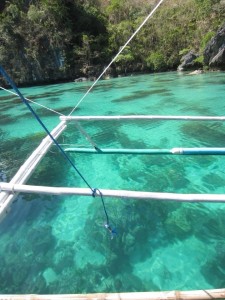A shipping lane is being proposed which would go through the Great Barrier Reef so as to improve access to a mining complex.
We must ask some questions that help decide whether the proposed lane should go through the reef or not. Who will benefit or lose out in each scenario, when, and for how long, and by how much?
In economic analysis, as £1 now is worth more than £1 in the future, future costs and benefits are discounted to create a Present Value for each impact, which you can then weigh against each other. For a project to be recommended on economic analysis grounds only, its benefits over time need to outweigh its costs. In economic terminology Net Present Value (benefits minus costs) > 0 or Benefit Cost Ratio > 1. There are of course many other considerations in making a decision about a project that economic analysis can capture. But let’s see how we can think about this project if we were attempting to do an economic analysis (cost benefit analysis in this case).
Let’s briefly look at the case where the shipping lane does go through the reef. This will not cost the company anything extra than they had already planned. It may, however, have an economic cost to society (a negative externality); reef damage, caused by the ships, will reduce tourism in the area- a huge source of local GDP and employment in Queensland.
We can also look at the case where the shipping lane is diverted to avoid the reef. The tourist numbers and revenues don’t change, but the diversion would cost extra money to the mining and shipping companies in the form of fuel and time.
The comparison of cost of diversion and avoided damage (benefit of diversion) to the reef can conclude:
(a) if the cost of diverting ships is less than the lost money from tourism and other marketable impacts, the shipping lane should be diverted.
(b) if the cost of diverting ships outweighs the lost money from tourism and other marketable impacts; the direct lane should go ahead on efficiency grounds.
But hang on a minute, it’s not that simple!
We have to think about the characteristics of the reef that generate values other than the market price and revenues. It’s these social values that are not paid for in a market that are often most important to people and are what make the Great Barrier Reef, well, GREAT.
It’s not that different to what people care about when their house burns down. Do people care about the games console or the expensive pair of new jeans? No, it’s the family photos, the postcards from friends, and the paintings your son made when he was 4 years old that hang in the kitchen.
The same goes for the reef; it’s the bio-diversity, cultural heritage, national pride, the wonder and mystery, and the sheer size of it that are the most ‘valuable’.
These characteristics lead to types of value that cannot be bought, such as: Option value (I may be willing to pay to have the option to see the Reef in the future, even though I have no intention going now); Existence value (I may be willing to pay for the knowledge that the Reef exists without any intention to ever see); and Bequest value (I may be willing to pay so that my descendants can see the Reef).
By including these values, we can build a better understanding of the Total Economic Value of the Reef. ‘But how do you measure them if we can’t buy or sell them?’ I hear you cry. This is where environmental economists earn their money; they realise that these values may be hidden within the price of another good/service that is bought and sold and thus can extract it. Another method is to survey people’s preferences of different scenarios regarding the environmental asset and their associated income in each scenario.
By eliciting these values, we can monetise damage done to the reef that isn’t seen through the market and incorporate it into the decision process.
Accounting for some leeway either side, if the true cost of having a lane directly through the reef i.e. losing all values associated with reef damage, is more than the cost to companies of circumventing the reef, then there is a compelling argument that the direct lane should be shelved.
So what if, even after including these non-marketed values, the damage to the reef is less costly than the cost to the companies of bypassing it?
In reality, we can’t monetise everything and we are never 100% certain what the consequences of reef damage is in the long term; perhaps, with data only available in the future, the costs are found to be so much more than previously thought. In that case, instead of attempting to put a market value on certain attributes, we could just say that, ‘some things are critical for nature and for the people, both now and in the future, and should be protected’.
Yes, economic development may bring us monetary wealth, but perhaps we lose immaterial wealth in the process in terms of wellbeing, morals and principles. Some things are irreplaceable, and should remain that way.
Here is a link to the online petition against the lane.

